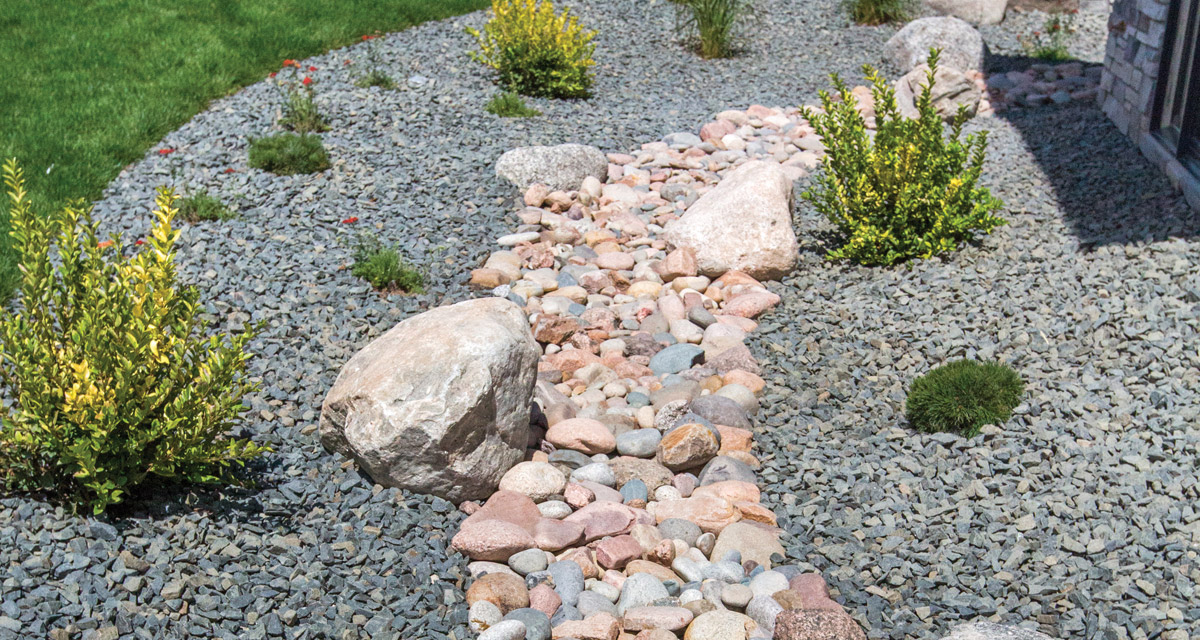Stonehenge.
The Moai Monoliths of Easter Island.
The ancient Pyramids of Giza.
All three phenomenal feats of architecture utilized one of Earth’s most plentiful resources with an intention. Not just to create an object of symbolism or beauty, but to create an impressive focal point. Across time, individuals used a builder or architect, landscaper or artist; today, those titles suit the all-in-one homeowner, who continues to seek ways to use rocks and stones purposefully. If you need an eye-catching idea to alter your landscape, the answer may be to consider a project with rocks and stones!
What is the Difference between a Rock and a Stone?
The cohesion of solidified mineral—such as quartz, feldspar, and mica—that form a mass is a rock. Although the words themselves are interchangeable, rocks can be rough and smooth, but only a stone can fit inside a pocket.
Rock Pathways
Similar to the shapes of clouds, rocks and stones catch our attention. We happen upon them in our wanderings, and discover once in a while the coloring or form is the only reason you need to transfer it home. You may be a collector of stones. When a few rocks become a pile, one solution is to create a pathway.
Consider, first, the type of pathway. Do you seek the natural element, where moss or creeping perennials fill the areas of dirt filled around your stones, or stones secured in concrete for less upkeep? Ensure the dirt is removed well-below the grass line and leveled flat. Add a layer of rocks to encourage drainage before placing handfuls of soil on top, and prior to adding each stone. Once you organize into piles according to thickness, choose the most massive for your pathway and smaller stones for decoration. Another option is to create your own “stones” by making flat, concrete tiles with personal themes, such as handprints, or embedded with objects.
The Stone Wall
While the first stone walls were loose field stones piled into a dry stack, the invention of mortar created impressive city walls, castles, and other fortifications. Since before the Middle Ages, the stone wall has been a successful and attractive building structure. While it does not necessarily take a professional, the effort takes time and patience. You’ll need to level the ground and add a bottom layer of small stones. Low walls only require one layer, while walls over three feet need a two- or three-stone depth to stand.
Tips: How-to-videos will assist in offering useful tips, essential tools, and stacking advice.
The Dry Creek
For aesthetic purposes, river stones in a variety of sizes and shapes can create a dry creek bed that winds through a garden or down the yard. The secondary goal is to channel water and solve drainage problems, erosion, or hide a barren location. Planting perennials to suit either drought-stricken or wet areas will add splashes of color.
Tips: Before starting, consider the width and the depth of your creek. Create the letter “v” and line with thick plastic. Low areas may change your desired course, unless you alter the shallowness to ease the flow. Test your creek frequently to fix the problems and ensure the waterway is gentle. Add striking features such as a small pond, waterfalls, or a design of “S-curves.” Plant an assortment of flowers along the path. Plan well!
Tower of Rocks
Stacking objects in a conical form is a natural curiosity. From an early age, children test their ability to balance by using hand-eye coordination to counterbalance the weight. You, too, can create a tower of rocks with the aid of a drill, rebar, and a diverse grouping of stones. As a decoration, the structure could be a simple attraction in a flower garden.
Creating a Memorial
In nature is where we often find ourselves looking high and low for signs. One of the easiest and therapeutic ways to honor a memory is by creating a memorial. Consider the possibilities of a statue or birdbath, a bench, or planting a tree. Creativity and personalization may help you find the perfect place to sit and find peace.
From small to large projects, you can begin investing time, and building with a timeless resource!




















